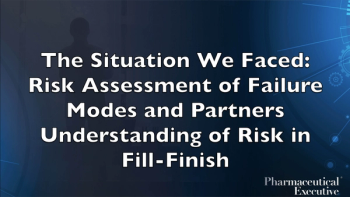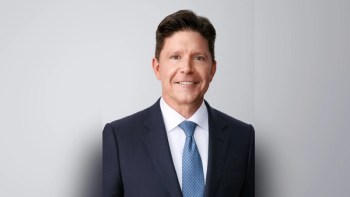
- Pharmaceutical Executive-03-01-2011
- Volume 0
- Issue 0
John Castellani: Industry's Level Bet on a Dizzying Future
Can PhRMA's own business model synch with industry's Pharm Exec takes a closer look at PhRMA's new leadership.
For Big Pharma, the track where "business meets policy" is a gutted one—or, as some would say, muddy as the road to Moscow in springtime. Not only is its reputation facing pushback from unfamiliar quarters—from criminal corruption vigilantes at the Department of Justice to the new GOP House leadership and grassroots Tea Party populists—but for the first time there are basic cost metrics to apply against the industry's own domestic policy commitments. These commitments now stand at approximately $90 billion and counting, just to help fund the cost of Obamacare alone. No one knows what the real number will be.
The industry has also had to confront breaches in its historic omertà-like code of silence, as evidenced by last month's harsh public verdict of Pfizer's former chief state government lobbyist on support for health reform—"one of the worst self-inflicted wounds in the history of lobbying."
Suffice it to say today's task of managing the industry relationship with the external world requires more than money alone; resources are not the issue. Someone has to finesse a finer point, working the "social thermostat" in daily testing the balance between the convictions that can lead to the deep freeze of confrontation or the thaw that accompanies a tactical compromise.
To fill that role, the Pharmaceutical Research and Manufacturers of America (PhRMA) has tapped a new leader: John Castellani, who last September replaced the ace-yet-polarizing politico, Billy Tauzin. Castellani's skill in managing sensitive CEO egos to build a series of successful multi-sectoral coalitions as head of the US Business Roundtable helped him win the position at PhRMA, where he leads a staff of some 160 people administering an annual budget of approximately $200 million.
PhRMA—and Castellani—in effect serve as industry's global spokesmen, as PhRMA's resources far exceed those of its main counterpart trade associations outside the US. The European Federation of Pharmaceutical Industries and Associations (EFPIA), which itself is embracing new leadership under the former Swedish association president Richard Bergstrom, and the International Federation of Pharmaceutical Manufacturers and Associations (IFPMA) each have less than one-tenth of what PhRMA spends every year. "The cooperation from John Castellani and the entire PhRMA team on cross-border issues of interest to both our countries has been extraordinary," Russell Williams, head of Canada's association Rx&D, told Pharm Exec. "Ours is a global industry and we need to develop a more global approach to engagement in all areas. Partnerships are essential to demonstrating the value of our industry and our medicines and vaccines."
Pharm Exec sat down with Castellani on Feb. 4 to explore where he sees the industry going and to discuss his vision for the organization over the next three years. Excerpts from the conversation reveal him as refreshingly direct in outlining what's at stake if the US fails to maintain basic support for medicines innovation.
Is there a prospect for this diverse, creative, and high-performance segment of American industry to become just another low-margin public utility? Yes. And with the cumulative weight of bad regulation it can happen literally overnight. Does the slow global devolution of the US automobile industry provide lessons to Big Pharma? Indeed it does. Decline is guaranteed for any industry that loses sight of the basic principle of good economics, which is maintaining value for the customer. This is why PhRMA members are working so hard to adjust the business model to changes in that customer base, and how PhRMA has to prioritize to ensure that external conditions are there to help ease the transition. In Castellani's words: "To the extent this industry gets identified as being built around the premise of government payouts for an imitative, aging commodity—the pill equivalent of cash for clunkers—we're all dead."
William Looney: PhRMA is one of the most visible representatives of an institution in transition—the Washington-based trade association. How are you adapting to change—representing an increasingly diverse constituency, shaping events in the midst of pervasive market uncertainty, and establishing clear metrics on public policies that provide the basis for commercial success?
John Castellani: The biopharmaceuticals industry is at a crossroads. Where we end up depends entirely on decisions that are now being made—by ourselves and also by the increasing number of stakeholders that shape a sector accounting for nearly one-fifth of GDP. Healthcare is being transformed by a variety of forces, both public and private. For us, the basic question is, Can we adapt so that US leadership in medical innovation continues or will we be relegated to the status of a public utility? We've heard this before, but no one quite accepted that our country would be presented with so stark a contrast in outcomes. I can assure you that the issue has now been joined; the stakes are very clear.
The high stakes are actually a positive for our industry. It means that PhRMA's strategy to cope with market change is now highly focused and thus easy to explain. We believe our 45 members are the single biggest driver of innovation in the healthcare system, providing not only life-enhancing medicines but—increasingly—services and processes that do four things: enhance quality, increase access, save money, and improve the efficiency of many complementary technologies. The patient is the first recipient of our work as well as the end beneficiary. To the extent that the patient represents the public, we perform a valuable societal role that stretches our remit beyond commerce.
WL: A clear vision is harder to realize when an industry is forced to confront wrenching adjustments to its historical business model. Certainly this is true in pharma and biotech today. Virtually every company is releasing earnings reports that emphasize cost cuts and layoffs rather than new investments in R&D. How do you continue to make the case for advancing innovation when the pervasive sentiment is retrenchment?
JC: One of the priorities I have set for PhRMA is to explain to our stakeholders how innovation fits in the broader economic cycle. You cannot escape the economic cycle, no matter which industry you are in. Demand for medicines is down, and that has a short-term impact on resources available for innovation. But what is notable about our industry is we still invest for the long-term; our members' R&D commitments—which far exceed the annual budget of the entire National Institutes of Health (NIH)—can actually help reverse the cycle and speed recovery. Few other industries have such long lead times in the way they spend money. You don't see all the positives until toward the end of the development cycle.
We also have to communicate the changes taking place in science. Medical innovation has always been costly, but today it is more than that—it is transformative, in that success is not predetermined, and the process of discovery and development is hard to institutionalize through the standard organization chart. Capturing the assets derived from good science requires a different, far more flexible, networked, and open-ended model for organizing the business.
John Castellani, President and CEO, Pharmaceutical Research and Manufacturers of America (PhRMA)
Innovation is equally shaped by three contending socioeconomic forces: the patient's desire for accessible and affordable healthcare, government payers seeking more fiscal responsibility, and investors who wish to maximize their ROI. While the industry is still on a learning curve here, PhRMA believes these three objectives actually complement each other. Companies have to be smarter and more efficient in the way they manage drug development and discovery because there is no longer one fixed way to achieve pipeline success.
View from the Top
WL: You assumed your current role in September 2010. Six months in, what leadership skills are most vital in running a major trade association like PhRMA?
JC: Even in the context of a single industry like pharmaceuticals, there are diverse interests and distinctive personalities—you cannot be tone deaf to that. So a basic test of leadership is to help our CEOs identify priorities that make sense as a collective mandate that advances the position of the industry rather than what one might follow as an individual company. Targeted execution of these priorities is equally important. There are an endless number of issues that a big organization like PhRMA can engage on. In the age of the "Twitter feed" cycle, the temptation is to swing at everything that comes our way. It's these distractions fed by the 24-hour news cycle and all the insider beltway buzz that can de-motivate staff, weaken our messaging, and make our resource deployment less effective. "Are we focusing?" is the question I ask myself every day. Try to do it all and you end up being successful at nothing.
WL: Distractions work both ways. How does PhRMA make sure its advocacy is recognized and incorporated by key stakeholders, who face equally severe constraints on their capacity to absorb information as the basis for informed decision-making?
JC: This is a significant challenge because the number of registered lobbyists here in Washington alone has doubled in the past five years. Much of the growth is taking place among interests that are not linked to big business. Hence fighting for "share of voice" is increasingly a matter of demonstrating value to the policymaker—you can't establish credibility just on the basis of whom you represent.
PhRMA is a service business whose product is information and evidence that is useful to the policymaker. Our perspective has to be accurate and credible in the context of recognizing that there is always an opposing view. It must contribute to solving a problem or creating a new opportunity. Above all, we have to be politically savvy; to understand what the underlying motivations are that drive policy and will lead to a resolution—a result that works. I can't go to a member of Congress or a state legislature and give them something that will compromise their position with peers and just lead to more stalemate.
There is more, too. We have to surround the decision-makers with broader grassroots advocacy. If we can convince them to support our position, then we also must ensure they are rewarded for that by the constituencies that determine their future. Lobbying is different today; rare is the case where we can be successful by sitting down for an off-record meeting with a politician or government official and wrap it all up in an afternoon. Grassroots work is costly and time consuming, taking up roughly one-third of our budget. It's a continuing strategic and operational priority for PhRMA.
Delivering the Message
WL: Your predecessor, Billy Tauzin, on assuming the post of PhRMA President, noted the following as his signature statement: "The era of no comment is over." What is your carve-in-stone communication to the public?
JC: "PhRMA—ready to partner." This industry exists to advance the future of medicine and improve patient health through active participation in many different healthcare policies. The other part of the message is economic—yes, we save lives. We also grow GDP.
WL: How do you accomplish that?
JC: It is primarily one of evidencing expertise. To demonstrate to payers, governments, and other stakeholders that we know the answers to the most challenging questions, such as how to transform basic science into commercial medicines that treat and cure real diseases, or how to build innovative systems and processes that guarantee the best healthcare for patients. It means PhRMA must be regarded as an expert—a thought leader—rather than a combatant in the political arena.
It goes without saying this is a significant challenge because sheer political clout does count. It is troubling that when President Obama visited Pennsylvania after the January State of the Union address to showcase his commitment to innovation, the sector he chose to celebrate was alternative energy, not our industry, which dominates the state's base in high technology. Why is that? Biopharmaceuticals is an industry that everyone wants. We've got to make sure as a society that we keep it strong.
WL: The industry today is far more competitive and one can point to a divergence of business interests in key areas—including support for generic medicines or new regulatory pathways for emerging technologies like biosimilars. How is PhRMA seeking to bridge these differences to set the clear priorities you claim are vital to prevail in Washington?
JC: Such differences are exaggerated. All of our members agree about the role of generic medicines in the healthcare system; innovation remains the critical driver because of the simple truth that all generics in use today were once a patented medicine. Although we have some member companies with active generics businesses, all of them are active in proprietary research and are working to discover new drugs. No PhRMA member is antagonistic to our basic mission around innovation, especially when we cast that concept in a broader framework—there are many new ways of defining innovation beyond producing a pill.
WL: What about forging a common position on sensitive commercial issues such as the application of codes of conduct on promotion and marketing?
JC: We reviewed this topic at the last meeting of the Dolder group of industry CEOs. Our common position—to be pursued by all national and regional trade associations, including PhRMA—is for our members to observe the highest standard of compliance, on a worldwide basis. We also set a fine line between what PhRMA does on the public policy front and the actions individual companies take in deciding when, where, and how to compete. Our task is to shape the broad environment in which this competition takes place; to create the level playing field that gives everyone a fair start. The other aspects are not part of our purview and I am very explicit and insistent that our members understand this.
Top of the Food Chain
WL: Of these broad policy issues, which is the most important to you right now?
JC: The issue that "binds all" is reimbursement. It is central to the four tasks I noted earlier as being PhRMA's mission. And it drives the fundamental question of healthcare today—how to establish value in the delivery of healthcare, in our case by giving providers the flexibility and access in prescribing that leads to the best outcome for the patient. We have not as a society resolved this question, despite the fact that the US faces a tidal wave of chronic disease. The way reimbursement works right now, the incentive is to pay for a diabetic's amputation rather than the insulin that would prevent it. There is no margin for investments in prevention and wellness, which hurts us because medicines are often the first line of attack in any strategy to avoid acute care, institutionalized interventions that cost our system billions of dollars each year.
A simple statistic says it all: Drugs constitute only a little more than 10 percent of total health spending, yet they account for upwards of 40 percent of what the average patient has to spend out of pocket for healthcare each year. In practice, this means the consumer will be driven to rely on acute care services that cost him less rather than use the drugs that are a better deal when you look at the treatment costs systemwide.
Our challenge is to turn this debate about costs on its head, to force people to think logically, and to put more emphasis on the long-term. You may have seen several new reports—not sponsored by PhRMA—that estimate the total economic cost of Alzheimer's disease alone will reach $1 trillion annually by 2050. That's about as much as what we pay for the entire cost of healthcare in the US today. The biggest-selling drug on the market brings in about $11 billion dollars [annually]. Does it not make sense to invest around an approach that would build the incentive to develop drugs with high revenue potential in treating an unmet medical need—to spend $11 billion to ameliorate a far bigger, trillion-dollar liability?
WL: Where are the policy gaps that PhRMA needs to fill?
JC: The defense of innovation is central to everything we do, so as part of that, we must work to promote PhRMA as a key player in science. The debate is not just about economics and politics. We have to provide a voice for the science of discovery. Our scientists have to be mobilized to help shape the environment where innovation takes place. Drug regulation is another area of growing need. The regulatory process in science is no longer a technical sidebar for a few industry specialists. It's a strategic priority that—done right—can reduce the time, cost, and uncertainty of drug development.
And of course we have to continue to review how we communicate our messages, particularly in the online space. Last month, PhRMA launched a new website and I will contribute to our new blog ("The Catalyst"), just as I did when I was at the Business Roundtable.
What fuses all this together is PhRMA's reputation as a thought leader. Ultimately, perception of the industry is influenced by our role in the delivery system of healthcare. Do we contribute in a way that positions us as a reform leader to make the system more innovative, accessible, and affordable? It's not effective to be seen as a force for "No," avoiding the search for new solutions because we define our task as just selling a medicine.
Reform Reflection
WL: Is this the motive that drove PhRMA to support the health reform legislation last year? Some observers criticized the strategy as shortsighted and predicted the Obama Administration would renege on its commitments to the industry.
JC: PhRMA continues to support all Americans having access to high-quality and affordable healthcare coverage, services, and treatments. Just how we get there is what's being debated in the halls of Congress and in courts across America right now.
I think most Americans recognize that the healthcare reform law is not perfect and that it needs to be improved. While there are disagreements in Congress on how it could be improved, policymakers have the difficult job of trying to navigate through some tough waters and doing what they believe is best for the future of healthcare in the US.
I can tell you that one provision in the law that continues to concern members of Congress on both sides of the aisle—and a broad array of other healthcare stakeholders—is the Independent Payment Advisory Board (IPAB). This Board will be in charge of slashing Medicare spending, which could result in access restrictions for millions of seniors. Since the law was enacted, we have said that this provision should be repealed so that seniors don't have to face cuts to important medical services and treatments.
As to your other point, if you look at the recent earnings reports of many biopharmaceutical companies, you will see that the healthcare reform law has already had a significant impact on their bottom lines. Any more hits—for example, damaging public policies—to this job-creating, innovative industry could very well hurt future R&D and impact US-based biopharmaceutical jobs. For this reason, we will continue to advocate for good policies that value innovative sectors such as ours so that we can continue to advance patient care and help improve the US economy.
WL: Is PhRMA a US organization or a global organization? How do you define yourself geographically?
JC: We are a US-based organization, but from a practical standpoint our mandate has to be global. The issues we face in Washington are similar to what is going on in Sacramento and Berlin and Tokyo or
Ottawa. In that sense we are a mirror to our own members, who no longer see themselves as US companies with a view that begins and ends here—and can be extended elsewhere, relying on the same rule book. They have made the transition from the old multinational model to the integrated global organization, and so have we.
How we approach this from a resource and organization perspective is twofold. First, we apply the capabilities of our international staff here at HQ to promote policy reforms in key regions and markets, with a current strong emphasis on Asia and the emerging markets. Second, we are participating in networked approaches with our two sister regional and Geneva-based trade associations—EFPIA and IFPMA—as well as with the major national associations like JPMA. We set common strategies that start from the premise that if you can solve it here, you can solve it there, and vice versa.
The best example I can cite is that our international and domestic budgets were once separate; now they draw from the same pool. Likewise, we now have in place a single organizational reference point for all our advocacy/stakeholder outreach activities: federal, state, and international. It's led to a lot of common learnings that we can apply successfully across functions and geographies. I look at it as the model for the entire organization. Frankly, we have to do more of that in our relationships with the emerging markets, where we are not as advanced as we could be. I see a big opportunity for progress in China, where the 20 most responsible companies have just formed a new trade association. My expectation is that some of these companies will eventually become members of PhRMA.
WL: How strong is the membership base? Is there a future for PhRMA in biotech and are you working to address the impact of defections like Roche?
JC: All of our member companies are active in biotech, so we position ourselves as a biopharmaceutical organization. Our membership base is strong—we have more members today than at any point in our history. To keep our members, the board has to feel engaged. One way I am doing that is to emphasize that board meetings be reserved for making decisions on strategic issues. We avoid procedural matters—they can be resolved by reading a paper in advance.
Future Prospects
WL: What other issues will PhRMA be focusing on this year?
JC: Chronic disease is an overarching priority. We have a number of broad program initiatives under way that involve outreach to other stakeholders. It's a major effort for us. In light of our renewed focus on regulatory issues, we will be spending time on the PDUFA reauthorization process. Regarding the Obama Administration's Affordable Care Act, we want to see improvements, the most important of which is repealing the Independent Payment Advisory Board to control Medicare costs, outside the purview of the legislative process. In addition, we face yet another year of debate on patent law reform. The outcome is crucial to our members, which account for about two-thirds of all the patents held in the US life sciences sector.
WL: What does Sanofi-Aventis CEO Chris Viehbacher intend to achieve in his current term as PhRMA Chair?
JC: Putting PhRMA in the center of the discussion on managing chronic disease is important to him—it should be embedded in all that we do. The other issue he is keen on is promoting awareness of the economic presence we have and our industry's contribution to global competiveness through innovation. His message is that we have to be less shy about that contribution, particularly in documenting the "multiplier effect" from industry investment in research.
WL: Looking ahead two or three years, how will you define your success?
JC: I intend to evidence progress in two areas. First, that we have an effective organization working seamlessly toward the specific objectives defined by the board and our member companies—and that I can produce clear metrics to demonstrate we have met those objectives. The second goal is to move the debate on medicines and healthcare in a different direction. To take it away from the politics of scarcity to a position that shows people understand, value, and are willing to reward the innovative process.
This latter objective will not be easy to achieve. There are many forces that will argue for the opposite. An organization that keeps me awake at night is the Congressional Budget Office (CBO), which is responsible for scoring the budget and economic impact of government activities. Right after I arrived at PhRMA last September (2010), I found one of its reports on my desk, stating that a reduction in obesity rates would actually drive up health costs by some $240 billion a year because thinner people live longer. What a narrow frame of reference! It's statistical absurdities like this that will give us the wrong answer for the long-term. It's a noble endeavor to fight it.
Articles in this issue
almost 15 years ago
Pharmaceutical Executive Digital Edition - March 2011almost 15 years ago
PICASSO—Truly a Work of Artalmost 15 years ago
The Netherlands: Innovation through Collaborationalmost 15 years ago
Restructured for Successalmost 15 years ago
The "Other" Innovationalmost 15 years ago
Where have all the Scientists Gone?almost 15 years ago
Making Sense of Market Chaosalmost 15 years ago
Pharm Exec's Seventh Annual Media Auditalmost 15 years ago
New Tools Track Safety, Value in Medicinealmost 15 years ago
A Rule of Thumb Gets Shot DownNewsletter
Lead with insight with the Pharmaceutical Executive newsletter, featuring strategic analysis, leadership trends, and market intelligence for biopharma decision-makers.





